Canaries are famous for their song; but some breeders are more interested in other traits. The many varieties of Canary fall into three broad groups - those bred for type (physical features or shape), those bred for colour, and those bred for song.
Type Canaries
Breeders who keep Type Canaries are interested in form, shape and size, rather than colour or song. Over the last 200 years many varieties have been developed. These are the most common and/or popular ones; but this list is by no means comprehensive, as there are almost endless variations on the theme.
Belgium or Belgian Bult
This variety was developed in the late 17th century, the first of the Canary types bred specifically for shape rather than song. And this is a particularly odd shape – a thin, round-shouldered bird, with a vulture-like stoop. The original Belgiums were around 155mm long, but the modern version has shed a few millimetres. Belgian Canaries are uncommon - breeding lapsed when Belgian breeders had other things to think about in the Second Word War - but they were used to develop some later popular breeds such as the Yorkshire (see below) and regional variants such as the Muenchener (from Munich), the Rheinlaender (from Hilden in Germany) and the Japanese Hoso.
Bernois, Berner or Bernese
These birds have distinctive heads, the feathers giving the impression of a flat top with a protruding forehead. They have an erect stance, making them look even taller than their 160mm (6 inch) length. The variety hails from Bern in Switzerland.
Border, or Border Fancy
Named after the Border region between Scotland and England, where the bird was first established as a distinct variety in the early 19th century. Before 1890 the Border was known as the Wee Gem. I’m probably not alone in wishing this tag had stuck (in spite of it sounding like a type of lettuce). Ironically, given this early name, it has now been developed as a larger-than-average Canary variety, the standard length being 146mm.
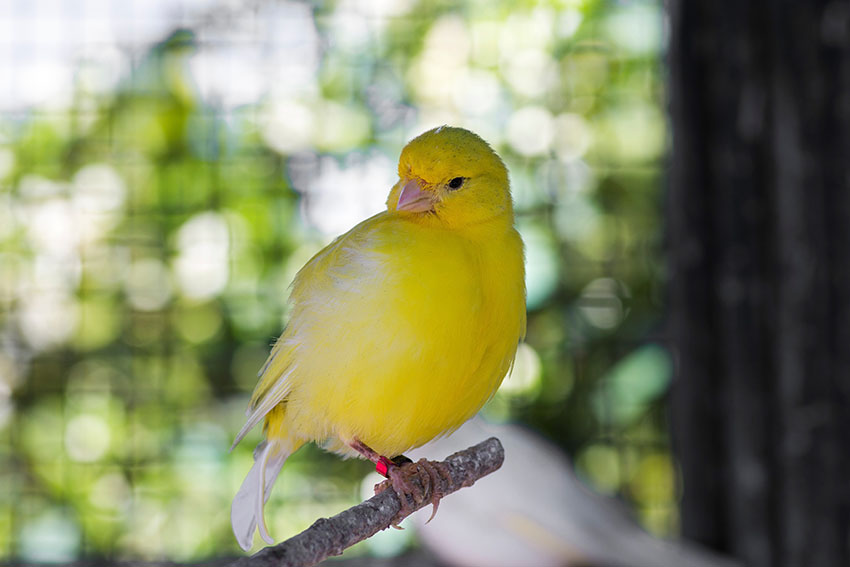
Border Canary
Most Borders are yellow, but they can be found in a wide range of colour combinations. The defining features are the size, the stance (standing at a 60 degree angle to the perch), a silky smooth coat of feathers, and a plump, rounded profile, with a body resembling a large feathered egg.
Columbus Fancy
This is an American speciality developed in the 1920s, from a combination of Harz, Yorkshire, Lancashire, Gloster and Norwich Canaries. It’s named after the city in Ohio, rather than the man who sailed the ocean blue in 1492. It measures around 150mm, and is one of the ‘stocky’ varieties, with a short beak, a rounded head and chest, and a thick neck. It also has a crest.
Crested
The Crested Canary came about after breeders attempted to create the ultimate crested bird by combining Norwich and Lancashire cresteds. The head feathers are therefore very ostentatious; but this bird is not as popular as the Gloster, and consequently a lot rarer. It’s a large one, reaching 170mm (6.7 inches).
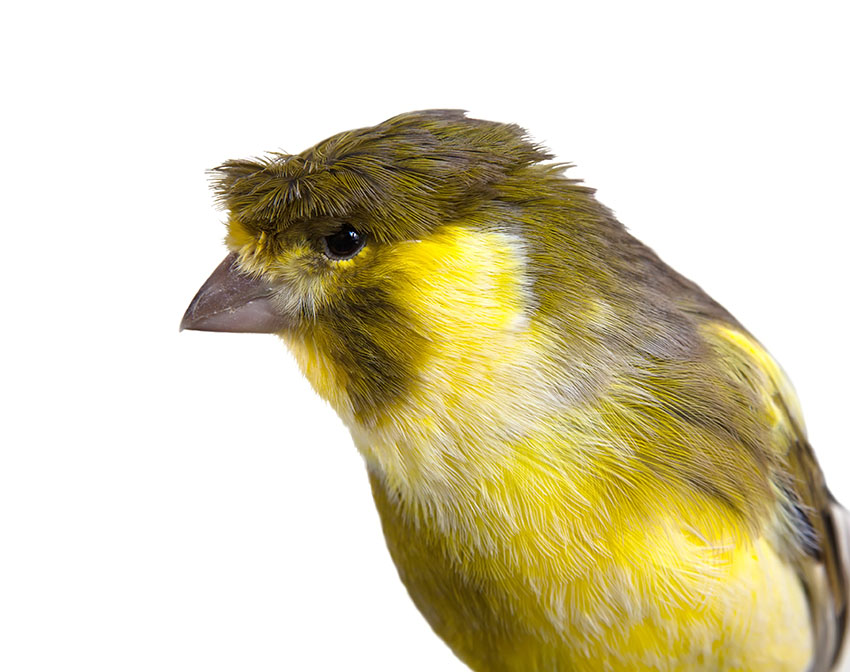
Crested Canary
Fife, or Fife Fancy
This is a miniature version of the Border Canary, bred for cuteness in the mid-20th century in Fife, Scotland. At 114mm (4½ inches) it’s the smallest common Canary variety.
Frilled
These birds have mutated feathers, making them look as though they have just come in from a hurricane. The effect is either pretty or messy, depending on your viewpoint. The feathers curl inwards, upwards and outwards in various places, rather than straight down from head to tail. The areas affected are the back, chest and flanks, with feather formations referred to as a mantle, jabot/craw and fins, respectively.
The birds themselves were developed from Dutch Canaries in the 1800s. There are many frilled types around today, the most popular being the Parisian (or Parisian Frill), a bit of a monster at up to 210mm (8.25 inches), which has been a feature at Canary shows since the 1850s.
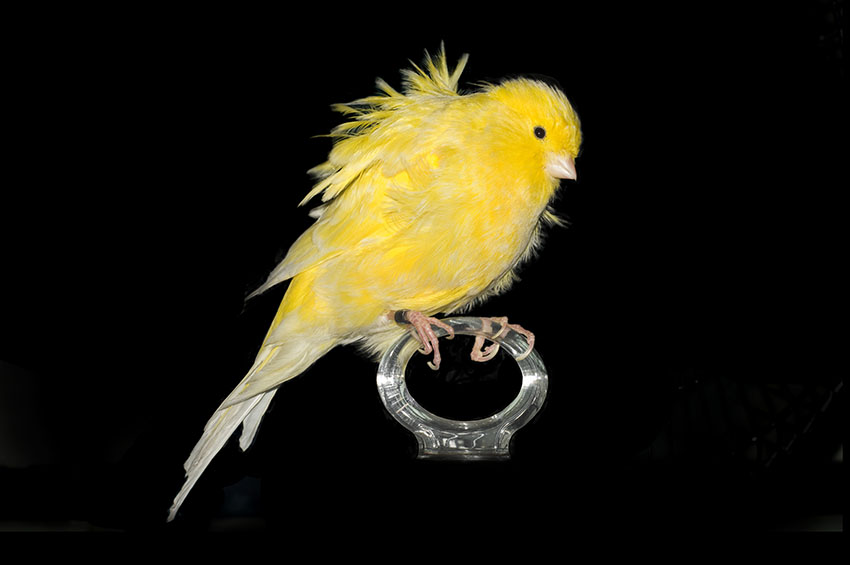
Frilled Canary
The Northern Dutch Frill and Southern Dutch Frill are also popular, measuring 4cm less than the Parisian. In spite of the name, these were developed in Belgium and France respectively, from the hunchbacked Belgium variety. They are the genetic forebears of the vulture-like stoop seen in many frilled Canary varieties today. This tendency is at its most pronounced in the Humpback Frill. Other misshapen varieties include the Gibber Italicus from southern Italy; the Makige Frill from Japan; the Melado Tenerife (Melado Tinerfeno) from Tenerife; the Spanish Giboso (Giboso Espanol); and the Swiss Frill.
In all there are around 20 recognised Frilled Canary types. Other popular ones include the Northern Frilled from France; the Paduan (or Padovan) from Padua, Italy; the huge Italian Gigant Frill (aka Arricciato Gigante Italiano Canary), which has a minimum length of 210mm (8 inches); and two diminutive types (both of them just 125cm (5 inches) long), the Florin (Fiorino) from Florence in Italy, and the Mehringer from Mehring in Germany.
Gloster
The Gloster – originally spelled Gloucester, but that proved confusing for breeders outside England – was developed as a variety in Gloucestershire in the late 19th century, and is now a very popular show bird. Its popularity peaked in the 1960s, as the mop-top arrangement of feathers on its head made it look like a cartoon Beatle.
The variety is short and squat, just 120mm (4.75 inches) long. It was bred into existence by crossing Herz, Border and Crested Canaries. The feather ‘wig’ is not actually present on all birds – the ones with it are called Coronas, and those without are Consorts, or Plainheads. Coronas can’t be bred together, as due to the complexities of genetics and inbreeding, the chicks never survive.
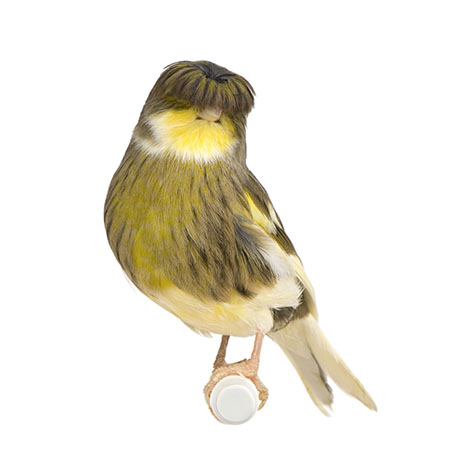
Gloster Canary
Harlequin Portuguese
These are very smart, straight-backed, round-chested birds, like little Sergeant Majors. They come in crested and non-crested varieties, and measure 160mm (6.25 inches) from beak to tail tip.
Irish Fancy
Ireland’s main contribution to the melting pot, these are small, erect birds (127mm (5 inches) long), without the plumpness of most smaller varieties.
Jaspe
This is a newcomer, developed in the last 10 years. It’s a bird with dilute or pastel colours and is the product of a dominant gene - i.e. a Jaspe bred with another Jaspe will always produce a Jaspe. The mutation was introduced into the Canary gene pool via crossbreeding with three species of wild siskin, although the breed is now self-perpetuating without the need for hybridisation.
Lancashire
Also known as the Manchester Fancy or Manchester Coppy. These are tall, thin and crested, measuring up to a whopping 230mm (9 inches). They were developed in the early 19th century, and have been used to add size to subsequent varieties.
The Lizard
These birds were first isolated and selectively bred in France in the 17th century. They were distributed more widely at the end of that century when Protestant French Huguenots fled from persecution in their home country, taking their pet Lizard Canaries with them. The variety nearly disappeared after the Second World War, when a combination of disease and an otherwise-occupied Canary-fancying community reduced specimens to a few dozen. Post-war, the breeders - and hence the Lizards - rallied, and it remains one of the most popular Type Canaries. Its song is amongst the least impressive of its tribe; but, again, that’s not why it was bred.
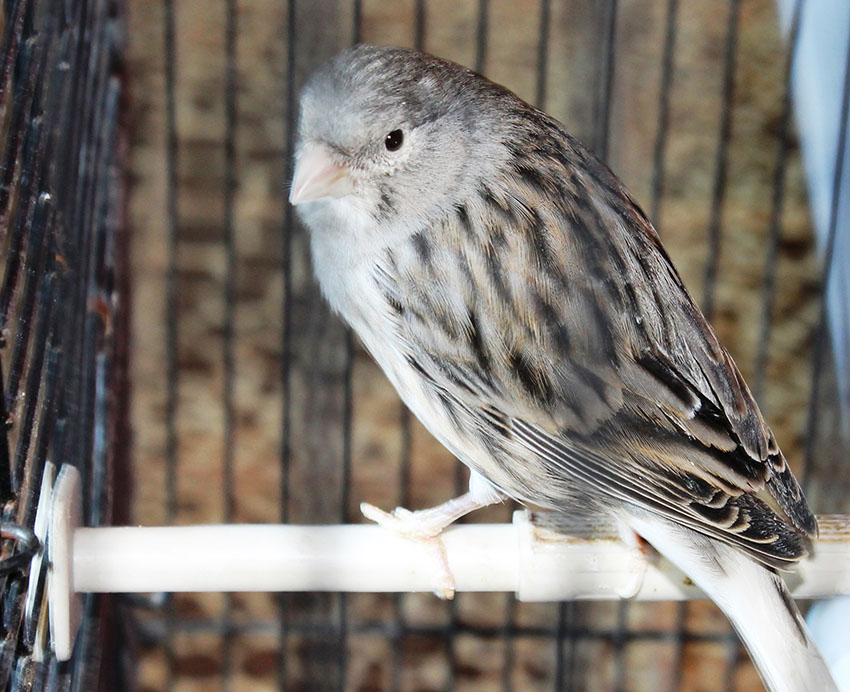
Lizard Canary
The name derives from the black crescent-shaped marks on the bird’s back and breast, suggesting the scaly coat of a reptile. The effect is very striking, and is referred to as spangling and rowing (on the back and breast respectively). Lizards also have an oval or circular mat of thicker-than-usual feathers on top of the head, giving the appearance of a cap. The scaly pattern is less pronounced after the bird’s first moult (and gradually disappears as the Canary gets older), so show winners are always young birds, pre-moult.
Norwich
These were the original ‘mop tops’, (and were combined with crested Lancashires to produce the Crested, which in turn were thrown into the gene pool of the Gloster). The variety was brought to East Anglia by Flemish immigrants in the early 18th century. The birds are larger than average, with fluffy, bulky head feathers, even when the crest is absent.
Red factor or Rubino
This is a genuine hybrid, a cross between a yellow Canary and a red siskin (Carduelis cucullata). The hue ranges from pink and orange to deeper shades of red, and the bird has been combined with many other types to introduce red coloration. Red factor birds require a diet rich in beta-carotene to maintain the colour when they are moulting and sprouting new feathers.
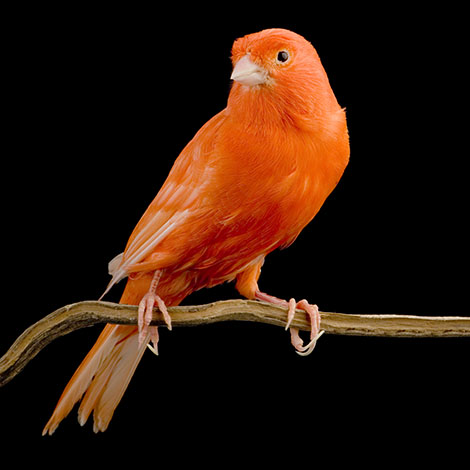
Rubino Canary
Scottish or Scotch Fancy
This type was developed from Belgium Canaries in the early 19th century, with a focus on the bent-backed posture. Glasgow and central lowland Scotland were the main breeding grounds, hence its early title of The Glasgow Don.
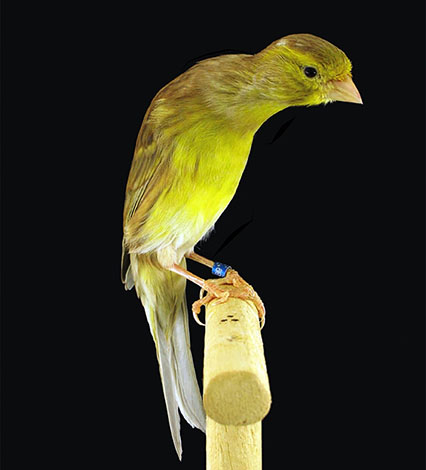
Scotch Fancy Canary
The thin, bent-backed body also lent the nickname The Bird o' Circle. It is a most peculiar little bird, as it has been bred to come as close as possible to a semi-circle in profile (or a quarter circle, to be more accurate), from the tip of its beak to the tip of its tail. Three Scotch Fancies together should form a perfect circle – a weird thought.
Spanish Llarguet
This is another bird bred for slender length and upright stance (sitting at 60 degrees to the perch). It’s also a large one, at 170mm (6.7 inches), with a noticeable long, narrow tail with a forked tip. It was developed in the Castelo and Valencia regions of Spain.
Spanish Raza
This bird was bred as a small songster in 19th century Spain, although in bird shows it isn’t categorised as a ‘Song Canary’. It’s a small one, with a length of 115mm (4½ inches), a slim build and a small head.
Stafford
These were first bred in the 1980s in Staffordshire, in a successful attempt to produce a small-crested bird with a red pigment. This entailed crossing Gloster Canaries with red factor birds (see above).
Warwick
This type became an accepted variation on the diverse Canary theme in the mid-2000s. It’s a small bird, around 114mm (4.5 inches), with an egg-shaped body, a yellow-ivory colouration, and a crest.
Yorkshire
At 152mm (6 inches), with a ‘no neck’ look married to a very upright stance, this variety has earned the nickname The Guardsman. It is the second biggest (as in longest) commonly available Canary type. It was first isolated as a variety in the mid-1800s in Bradford, Yorkshire, and developed to perfection in the 1930s. It was a piece of inter-county one-upmanship, with Yorkshire breeders trying to improve on the existing Lancashire variety by making a thinner, sleeker bird.




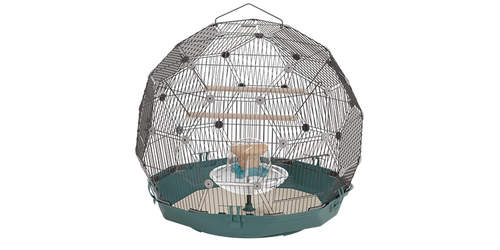
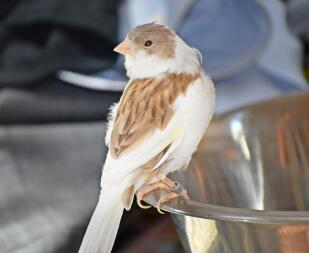
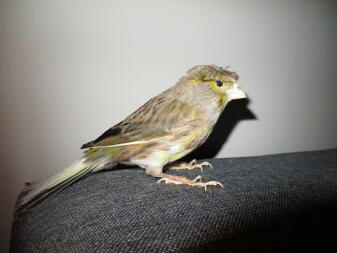
Comments
Aine, 27 May 2024
A canary is my favourite
Guy, 8 August 2022
Will the Fife Canary and the Border Canary inter breed
Tish, 1 January 2020
We have a red factor canary that, at 6 1/2 years has developed mutated feathers like a frilled canary on the breast and upper wing. The feathers never form beyond a small curled "'fist". Is this a result of aging or a dietary deficiency? I'd appreciate any insights you might have. We were feeding colored cornbread but have ceased this in the past year when the feathers showed a misshaped appearance. Thank you.
Calvin, 14 September 2019
Why do some baby canaries take longer to develop ? 2 out of 3 have left nest but the 3rd seems to be developing very slowly.
Catherine, 11 September 2019
Very interesting site giving lots of useful information regarding the little bird of many colours, size etc., etc., A beautiful little bird that gives, brings so much pleasure to a home. No home should be without one if you appreciate and have a love of nature. 10/10 for this information. Thank you!